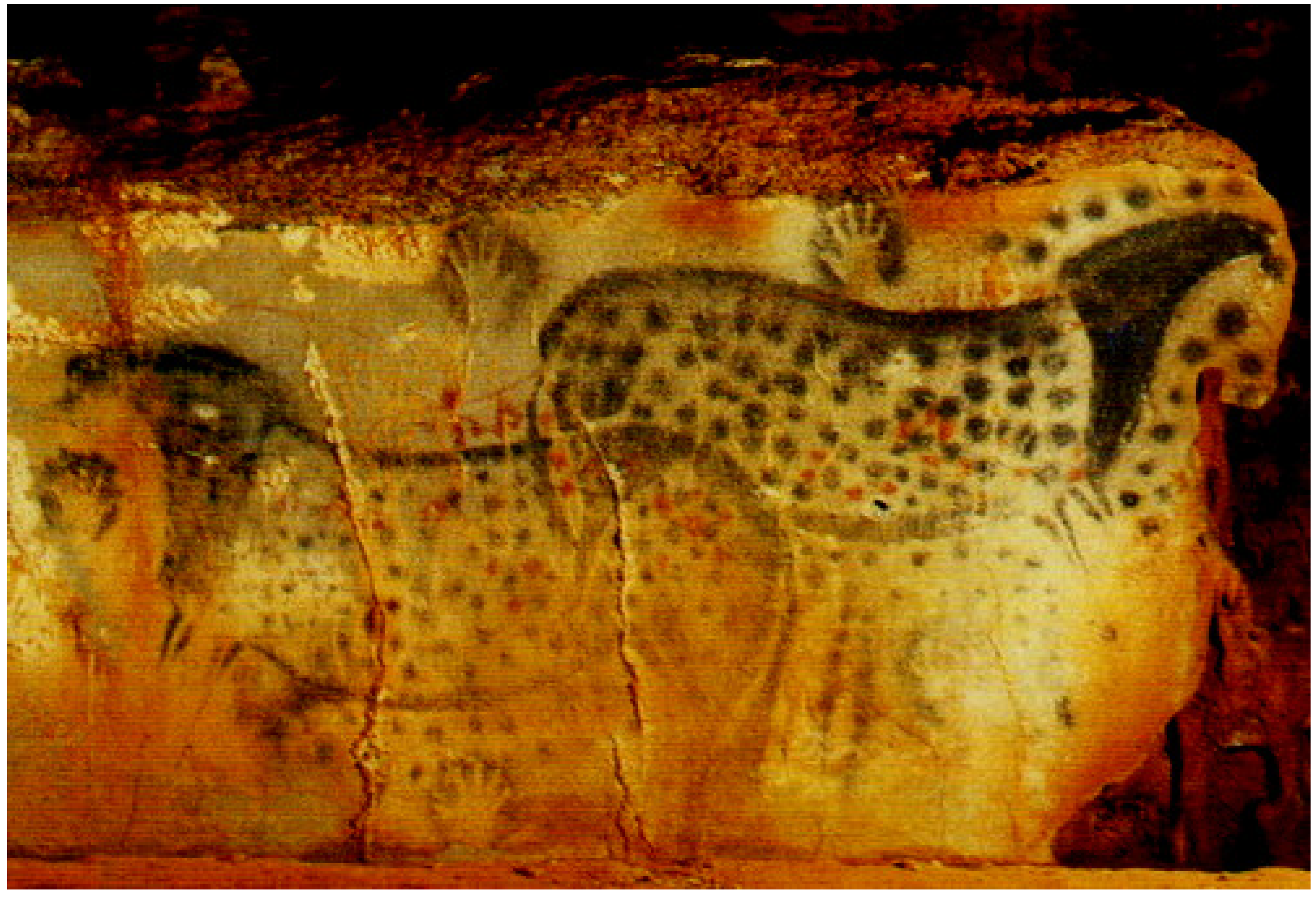The Significance of the Pech Merle Spotted Horses
Abstract
:1. Introduction
2. Ascertaining Veracity


3. Discussion
4. Conclusion
Conflicts of Interest
References
- M. Pruvost, R. Bellone, N. Benecke, E. Sandoval-Castellanos, M. Cieslak, T. Kuznetsova, A. Morales-Muñiz, T. O’Connor, M. Reissmann, M. Hofreiter, and A. Ludwig. “Genotypes of Predomestic Horses Match Phenotypes Painted in Paleolithic Works of Cave Art.” Proc. Natl. Acad. Sci. USA 108 (2011): 18626–18630, pp. 1–5. [Google Scholar] [CrossRef] [PubMed]
- R. D. Guthrie. “Ethologicial Observations from Palaeolithic Art.” In La Contribution de la Zoologie et de L’Ethologie à L’ Interpretation de L’Art des Peuples Chasseurs Préhistoriqùes: 3e Colloque de la Société Suisse des Sciences Humaines (1974). Edited by H. Bandi, W. Huber, M. R. Sauter and S. Bitter. Fribourg, Switzerland: Éditions Universitaires Fribourg, 1984, pp. 35–74. [Google Scholar]
- D. Hodgson. “The Biological Foundations of Upper Palaeolithic Art: Stimulus. Percept and Representational Imperatives.” Rock Art Research. 20 (2003): 3–22. [Google Scholar]
- G. Packer, and J. Clottes. “When Animals Ruled France.” Natural History. 109 (2000): 52–57. [Google Scholar]
- B. Knight. “Pech Merle Horses Really Were Spotted, Scientists Say.” Deutsche Welle. November 2011. Available online: http://www.dw.de/pech-merle-horses-really-were-spotted-scientists-say/a-15517588 (accessed 10 September 2013).
- B.O. Alpert. “The Meaning of the Dots on the Horses of Pech Merle.” MDPI Arts 2 (2013): 476–490. [Google Scholar]
- A. Ludwig, M. Pruvost, R. Bellone, N. Benecke, E. Sandoval-Castellanos, A. Morales-Muñiz, T. O’Connor, M. Reissmann, and M. M. Hofreiter. “Reply to Bar-Oz and Lev-Yadun: Horse Colours in Time and Space.” Proceedings of the National Academy of Sciences of the United States of America 109 (2012): E1213. [Google Scholar]
- J. Clottes. “Why Did They Draw in Those Caves? ” Time and Mind. 6 (2013): 1–14. [Google Scholar]
- J. D. Lewis-Williams. “Wrestling with Analogy: A Methodological Dilemma in Upper Palaeolithic Art Research.” Proceedings of the Prehistoric Society. 57 (1991): 149–162. [Google Scholar]
- P. Bahn, and J. Vertut. Journey Through the Ice Age. London: Weidenfeld and Nicolson, 1997. [Google Scholar]
- D. Hodgson. “On cognitive palaeontology and the infamous 'spotted' horse.” Interview with Taylor Burns in Nature Education by SCITABLE. November 2011. Available online: http://www.nature.com/scitable/blog/cognoculture/on_cognitive_palaeontology_and_the (accessed 10 September 2013).
- R. D. Guthrie. The Nature of Palaeolithic Art. Chicago: University of Chicago Press, 2005. [Google Scholar]
- D. Hodgson. “The Visual Dynamics of Upper Palaeolithic Art.” Cambridge Archaeological Journal. 18 (2008): 341–353. [Google Scholar]
- J. Igarashi. “Geometric Signs in Western European Palaeolithic Cave Art: Angular Signs (V-Shaped Angular Sign, Inverse V-Shaped Angular Sign, Arrow-Shaped Angular Sign).” Bulletin of the International Jomon Culture Conference (Tokyo). 2 (2006): 127–138. [Google Scholar]
- M. Lorblanchet. Art Pariétal: Grottes Ornées du Quercy. Rodez, France: Editions du Rouergue, 2010. [Google Scholar]
© 2014 by the authors; licensee MDPI, Basel, Switzerland. This article is an open access article distributed under the terms and conditions of the Creative Commons Attribution license (http://creativecommons.org/licenses/by/3.0/).
Share and Cite
Hodgson, D. The Significance of the Pech Merle Spotted Horses. Arts 2014, 3, 207-212. https://doi.org/10.3390/arts3020207
Hodgson D. The Significance of the Pech Merle Spotted Horses. Arts. 2014; 3(2):207-212. https://doi.org/10.3390/arts3020207
Chicago/Turabian StyleHodgson, Derek. 2014. "The Significance of the Pech Merle Spotted Horses" Arts 3, no. 2: 207-212. https://doi.org/10.3390/arts3020207
APA StyleHodgson, D. (2014). The Significance of the Pech Merle Spotted Horses. Arts, 3(2), 207-212. https://doi.org/10.3390/arts3020207



